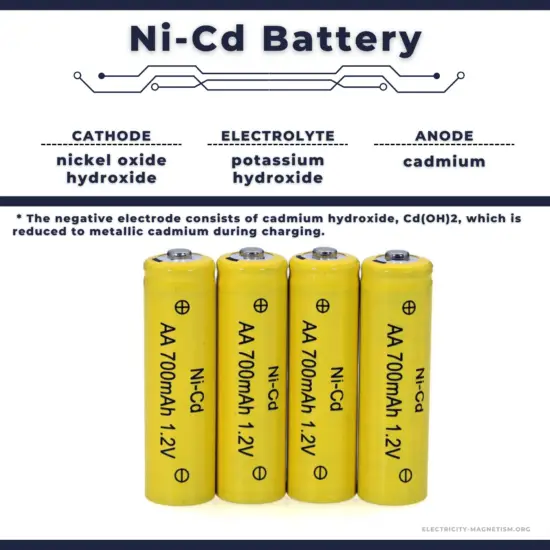30-second summary
Characteristics of Nickel-cadmium Batteries
The nickel-cadmium battery (Ni-Cd battery) is a type of secondary battery using nickel oxide hydroxide Ni(O)(OH) as a cathode and metallic cadmium as an anode.
A common open circuit voltage for Ni-Cd batteries (e.g. AAA and AA) is 1.2V. The battery has low internal impedance resulting in high power capabilities but lower energy storage capacity compared to other battery systems. It has long cycle life and the capability of rapid recharge but may suffer from voltage depression or memory effect, meaning that the maximum charge voltage will decrease and hence the energy capacity if continuously discharged shallowly.
The overall reaction during discharge is:
2NiOOH + Cd + 2H2O → 2Ni(OH)2 + Cd(OH)2

Nickel-cadmium Battery
The nickel-cadmium battery (Ni-Cd battery) is a type of secondary battery using nickel oxide hydroxide Ni(O)(OH) as a cathode and metallic cadmium as an anode. The abbreviation Ni-Cd is derived from the chemical symbols of nickel (Ni) and cadmium (Cd).
The battery has low internal impedance resulting in high power capabilities but lower energy storage capacity compared to other battery systems. It has long cycle life and the capability of rapid recharge but may suffer from voltage depression or memory effect, meaning that the maximum charge voltage will decrease and hence the energy capacity if continuously discharged shallowly. The greatest disadvantage is the content of cadmium. Unfortunately, cadmium is extremely toxic; therefore, the Ni-Cd will not be an alternative for a modern battery system.
Nowadays, the applications of nickel-cadmium batteries are in small-size portable devices such as power tools, toys, emergency lighting, medical instrumentation, or industrial portable products. It is used in small-size products because their cost for low-power applications is inexpensive but three to four times more expensive than lead-acid batteries for the same capacity.
Characteristics of Nickel-cadmium Batteries
To compare and understand the capability of each battery, some important parameters are characteristic of each battery, also within a type of battery. These parameters are a reference when a battery is needed, and specific qualities are required since batteries are used in all types of devices and for infinite purposes.
Cell Voltage
The voltage of electric batteries is created by the potential difference of the materials that compose the positive and negative electrodes in the electrochemical reaction.
A common open circuit voltage for Ni-Cd batteries (e.g. AAA and AA) is 1.2V.
Cut-off Voltage
The cut-off voltage is the minimum allowable voltage. It is this voltage that generally defines the “empty” state of the battery.
When testing the capacity of a NiMH or NiCd battery a cut-off voltage of 1.0 V per cell is normally used, whereas 0.9 V is normally used as the cut-off voltage of an alkaline cell.
Capacity
The coulometric capacity is the total Amp-hours available when the battery is discharged at a certain discharge current from 100% SOC to the cut-off voltage.
Ni-Cd AA batteries feature a nominal voltage of 1.2 volts and an average capacity of 600-1000 mAh.
C-rate of Battery
C-rate is used to express how fast a battery is discharged or charged relative to its maximum capacity. It has units h−1. A 1C rate means that the discharge current will discharge the entire battery in 1 hour.
NiCd batteries designed for fast charging can be charged with currents that are several times the C-rating without extensive heat buildup.
Self-discharge
Batteries gradually self-discharge even if not connected and delivering current. This is due to non-current-producing “side” chemical reactions that occur within the cell even when no load is applied.
The self-discharge rate for a Ni-Cd battery is around 10%/month at 20 °C, and rising up to 20% at higher temperatures. It is recommended not to store Ni-Cd batteries for an extended amount of time without occasionally using the batteries.
Degradation
Some degradation of rechargeable batteries occurs on each charge-discharge cycle. Degradation usually occurs because electrolyte migrates away from the electrodes or because active material detaches from the electrodes.
Ni-Cd batteries can provide 300 to more than 500 discharge/charge cycles.
Depth of Discharge
Depth of discharge is a measure of how much energy has been withdrawn from a battery and is expressed as a percentage of full capacity. For example, a 100 Ah battery from which 40 Ah has been withdrawn has undergone a 40% depth of discharge (DOD).








